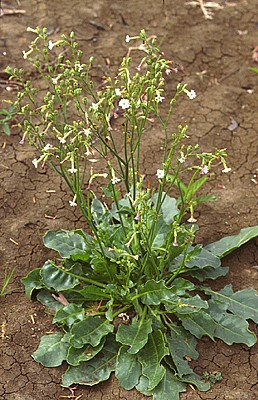
Synonymy
Nicotiana truncata Symon, J. Adelaide Bot. Gard. 18: 1–4 (1998)
T: 36 km SW of Oodnadatta, S.A.; 1 May 1997, D.E. Symon 15679; holo: AD 99721096; iso: BRI, CANB, K, MEL, MO, NSW, NT, PERTH.
Description
Annual (15-) 30 (-50) cm tall; stems and leaves glabrous.
Leaves mostly in a radical rosette flat on the ground, only in large vigorous plants are leaves elevated and one present at the first branch of the inflorescence; lamina commonly 10 x 7 cm, exceptionally 25 x 15 cm, ovate, narrowly cuneate below and continuing along the petiole as a narrow wing, apex rounded, somewhat fleshy, shiny green; petiole 5–12 cm long, narrowly winged above.
Inflorescences 1–5 or 6, from the rosette, the first branch at about mid point often subtended by a leaf, higher order branches subtended by a bract 3–4 mm long. Pedicel 3–5 mm at anthesis, lengthening to 15 mm in fruit. Calyx 5 mm at anthesis, tubular, truncate, the lobes reduced to acumens 0.5–1 mm long, pedicel and calyx minutely pubescent with glandular hairs. Corolla tube 15 mm long, 2 mm diameter, slightly contracted above the ovary and throat cup, slightly expanded about the anthers; limb c. 5 mm long, expanded to 10–11 mm diameter, the lobes rounded, slightly emarginate, white. Stamens 5, four with short filaments attached at the throat cup, the fifth filament attached to the tube near the ovary apex, its anther remaining below the others.
Capsule c. 10 mm long, 7 mm wide, apex projecting 2–3 mm above the closely investing truncate calyx, valves four. Seeds 1 mm long, reniform, coarsely reticulate. n = 18.
Distribution and ecology
Seasonally abundant along arid streamlines on the gibber plains between Coober Pedy and Oodnadatta in northern S.A.
Site possibly sub-saline and gypseous.
Notes
Similar in appearance to N. cavicola, but distinguishable from it by its subterete, rather than broadly-winged, petioles.
Calyx lobes are very short, giving the apex a "cut-off" or truncate appearance - hence the name of this species.
In South Australia classified as Rare under Schedule 9 of the National Parks & Wildlife Act 1972
Selected specimens
S.A.: NE of Coober Pedy, Giddi Giddinna Creek, D. Symon 15665 & J. Symon (AD, BRI, HO, NSW, NT, PERTH).






